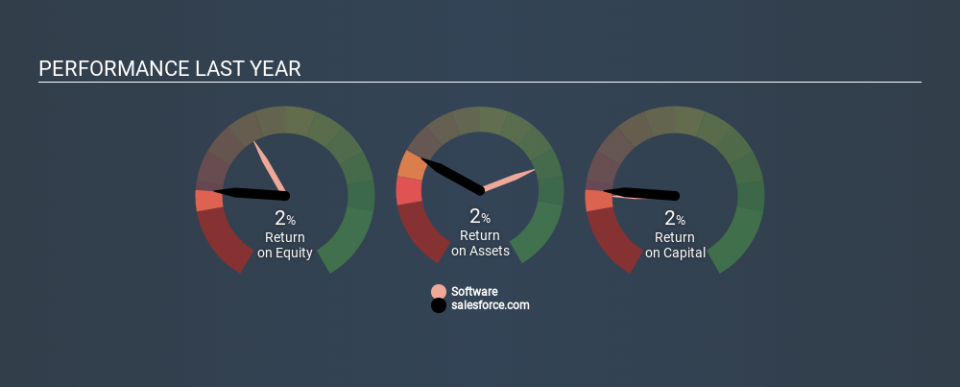Why We’re Not Impressed By salesforce.com, inc.’s (NYSE:CRM) 1.7% ROCE

Today we'll evaluate salesforce.com, inc. (NYSE:CRM) to determine whether it could have potential as an investment idea. In particular, we'll consider its Return On Capital Employed (ROCE), as that can give us insight into how profitably the company is able to employ capital in its business.
First, we'll go over how we calculate ROCE. Next, we'll compare it to others in its industry. And finally, we'll look at how its current liabilities are impacting its ROCE.
Return On Capital Employed (ROCE): What is it?
ROCE is a metric for evaluating how much pre-tax income (in percentage terms) a company earns on the capital invested in its business. Generally speaking a higher ROCE is better. Overall, it is a valuable metric that has its flaws. Author Edwin Whiting says to be careful when comparing the ROCE of different businesses, since 'No two businesses are exactly alike.
So, How Do We Calculate ROCE?
Analysts use this formula to calculate return on capital employed:
Return on Capital Employed = Earnings Before Interest and Tax (EBIT) ÷ (Total Assets - Current Liabilities)
Or for salesforce.com:
0.017 = US$663m ÷ (US$50b - US$10b) (Based on the trailing twelve months to October 2019.)
So, salesforce.com has an ROCE of 1.7%.
View our latest analysis for salesforce.com
Does salesforce.com Have A Good ROCE?
ROCE can be useful when making comparisons, such as between similar companies. In this analysis, salesforce.com's ROCE appears meaningfully below the 9.8% average reported by the Software industry. This performance could be negative if sustained, as it suggests the business may underperform its industry. Regardless of how salesforce.com stacks up against its industry, its ROCE in absolute terms is quite low (especially compared to a bank account). There are potentially more appealing investments elsewhere.
We can see that, salesforce.com currently has an ROCE of 1.7% compared to its ROCE 3 years ago, which was 1.1%. This makes us wonder if the company is improving. The image below shows how salesforce.com's ROCE compares to its industry, and you can click it to see more detail on its past growth.
Remember that this metric is backwards looking - it shows what has happened in the past, and does not accurately predict the future. ROCE can be deceptive for cyclical businesses, as returns can look incredible in boom times, and terribly low in downturns. This is because ROCE only looks at one year, instead of considering returns across a whole cycle. What happens in the future is pretty important for investors, so we have prepared a free report on analyst forecasts for salesforce.com.
What Are Current Liabilities, And How Do They Affect salesforce.com's ROCE?
Current liabilities are short term bills and invoices that need to be paid in 12 months or less. The ROCE equation subtracts current liabilities from capital employed, so a company with a lot of current liabilities appears to have less capital employed, and a higher ROCE than otherwise. To check the impact of this, we calculate if a company has high current liabilities relative to its total assets.
salesforce.com has total assets of US$50b and current liabilities of US$10b. As a result, its current liabilities are equal to approximately 21% of its total assets. With a very reasonable level of current liabilities, so the impact on ROCE is fairly minimal.
What We Can Learn From salesforce.com's ROCE
While that is good to see, salesforce.com has a low ROCE and does not look attractive in this analysis. Of course, you might also be able to find a better stock than salesforce.com. So you may wish to see this free collection of other companies that have grown earnings strongly.
I will like salesforce.com better if I see some big insider buys. While we wait, check out this free list of growing companies with considerable, recent, insider buying.
If you spot an error that warrants correction, please contact the editor at editorial-team@simplywallst.com. This article by Simply Wall St is general in nature. It does not constitute a recommendation to buy or sell any stock, and does not take account of your objectives, or your financial situation. Simply Wall St has no position in the stocks mentioned.
We aim to bring you long-term focused research analysis driven by fundamental data. Note that our analysis may not factor in the latest price-sensitive company announcements or qualitative material. Thank you for reading.

 Yahoo Finance
Yahoo Finance 
